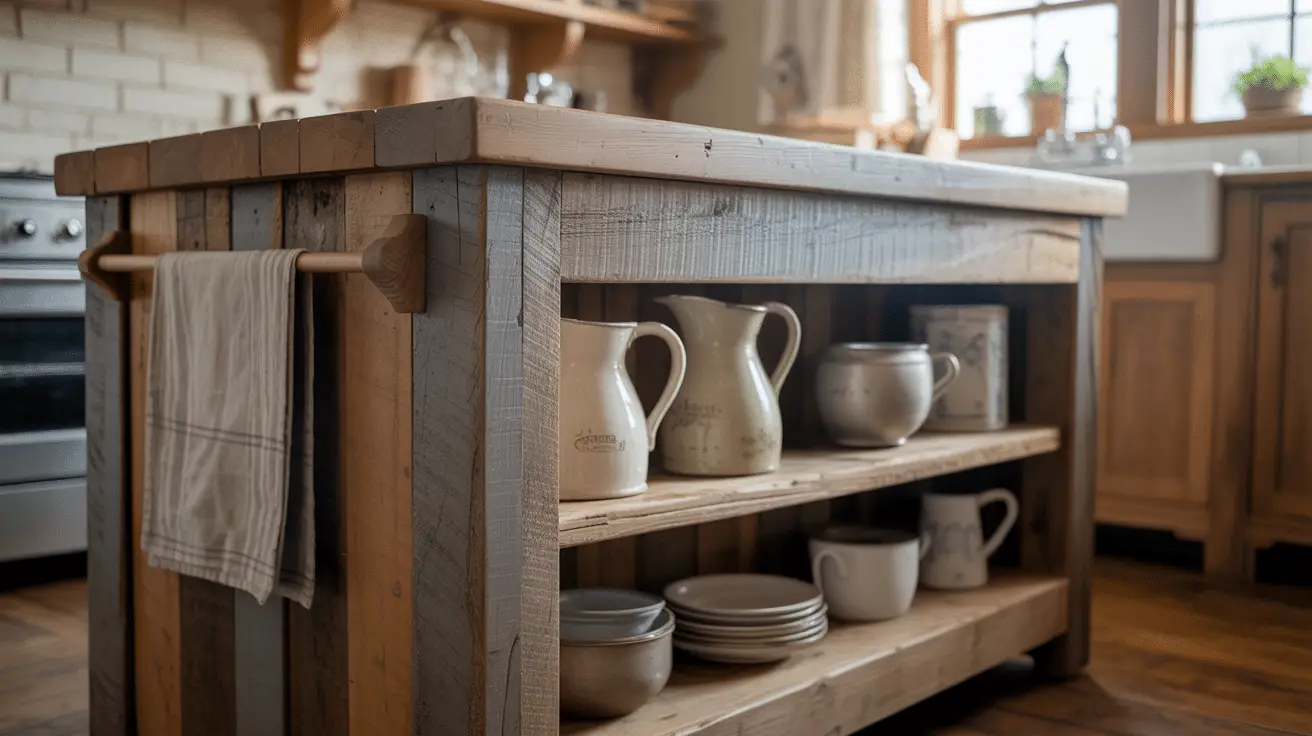DIY Rustic Kitchen Island Projects for Every Budget: Transform Your Kitchen with Style and Function
Table of Contents
Introduction
Imagine the heart of your home—your kitchen—transformed by the addition of a rustic kitchen island. Whether you’re an experienced DIY enthusiast or a beginner just dipping your toes into the world of home renovation, building or upgrading your kitchen island can be a rewarding project. Not only does it enhance the functionality of your kitchen, but it also adds character and warmth to your space.
Kitchen islands are more than just functional—they’re often the focal point of the kitchen, providing extra counter space, storage, and even serving as a gathering place for family and friends. But buying a custom, high-end island can be costly, and not everyone has the budget for a pricey remodel. The good news is that creating a beautiful, rustic kitchen island doesn’t have to break the bank. With a little creativity, the right materials, and a bit of time, you can build a charming piece that fits your style and budget.
In this guide, we’ll cover a range of DIY rustic kitchen island projects, from budget-friendly options that make the most of reclaimed materials to luxurious custom designs that elevate your kitchen’s style. Whether you’re looking for a weekend project or a more in-depth renovation, we’ll offer step-by-step instructions, tips, and inspiration to help you create the kitchen island of your dreams.
1. Budget-Friendly Rustic Kitchen Island with Reclaimed Wood
One of the most affordable ways to create a rustic kitchen island is by using reclaimed wood. This sustainable material not only adds character but also provides a unique, weathered look that perfectly suits rustic and farmhouse-style kitchens.
How to Create a Reclaimed Wood Kitchen Island
- Materials Needed: Reclaimed wood planks, screws, wood glue, saw, sandpaper, wood stain or paint.
- Step-by-Step Guide:
- Gather Materials: Find reclaimed wood from local salvage yards, old furniture, or even discarded pallets. Look for boards in varying sizes and textures for a more eclectic, rustic feel.
- Build the Frame: Start by building a simple rectangular frame for the base of your island. Use sturdy wood like 2x4s for the frame, ensuring it’s level and square.
- Attach the Wood Planks: Cut the reclaimed wood to size and attach the planks to the frame. You can alternate the direction of the planks to create a visually interesting pattern.
- Add Storage Options: To maximize storage, consider adding shelves or drawers. Reclaimed wood crates or baskets work well for adding storage space without compromising the rustic style.
- Finish and Stain: Sand the edges and surfaces for a smooth finish. Stain the wood to enhance the grain or leave it natural for a more rustic, weathered look. Apply a coat of clear varnish for durability.
- Gather Materials: Find reclaimed wood from local salvage yards, old furniture, or even discarded pallets. Look for boards in varying sizes and textures for a more eclectic, rustic feel.
Cost Breakdown:
| Material | Estimated Cost |
| Reclaimed wood planks | $50-$150 |
| Screws, nails, hardware | $10-$30 |
| Wood stain or paint | $20-$40 |
| Sandpaper, varnish | $15-$25 |
| Total | $95-$245 |
2. DIY Kitchen Island with Rolling Cart for Flexibility
If you’re working with limited space but still want the functionality of a kitchen island, consider building a rolling cart. A rolling island is a versatile option that provides extra counter space and can be easily moved as needed.
How to Build a Rolling Cart Kitchen Island
- Materials Needed: Plywood, caster wheels, 2x4s, screws, wood stain or paint, handles or knobs, power tools (saw, drill).
- Step-by-Step Guide:
- Build the Base: Start by constructing a rectangular frame using 2x4s to create the base of your rolling cart.
- Attach the Top: Use plywood for the top of the cart, ensuring it’s large enough to accommodate food prep or other kitchen tasks.
- Add Wheels: Attach caster wheels to the base of the cart. Make sure they are lockable for stability when stationary.
- Install Storage: Add shelves, a drawer, or even a towel rack to the cart. This will increase the functionality and ensure the cart is not just mobile, but also useful for storing kitchen essentials.
- Finish the Cart: Sand, stain, or paint the cart according to your style. You can use a rich stain for a more rustic look or paint it for a modern touch.
- Build the Base: Start by constructing a rectangular frame using 2x4s to create the base of your rolling cart.
Cost Breakdown:
| Material | Estimated Cost |
| Plywood | $20-$40 |
| 2x4s | $10-$20 |
| Casters (wheels) | $20-$40 |
| Handles, hardware | $10-$15 |
| Wood stain or paint | $15-$30 |
| Total | $75-$145 |
3. High-End Rustic Kitchen Island with Butcher Block Top
For those with a larger budget who want a statement piece, a high-end rustic kitchen island with a butcher block top is a beautiful and functional option. Butcher block is perfect for a rustic design while offering the added benefit of a durable, easy-to-maintain work surface.
How to Create a Butcher Block Kitchen Island
- Materials Needed: Butcher block countertop, hardwood (for the base), screws, wood glue, stain or finish, power tools (saw, drill).
- Step-by-Step Guide:
- Select Your Butcher Block: Choose a butcher block countertop from a local supplier or online. Ensure it’s large enough for your space and your needs.
- Build the Base: Construct the base out of hardwood such as oak or maple. A traditional farmhouse design works well with these materials. Use 2x4s for a sturdy frame and ensure it can support the weight of the butcher block.
- Attach the Top: Secure the butcher block to the base using screws or wood glue. Be sure to leave a small gap for expansion, as the butcher block will slightly change size with temperature and humidity.
- Add Functional Details: Install additional storage such as open shelves or a pull-out trash bin. If desired, add hooks for hanging kitchen tools or a wine rack.
- Finish and Seal: Sand the surface smooth, apply a stain if desired, and then finish with a food-safe oil or varnish to protect the wood and enhance its natural beauty.
- Select Your Butcher Block: Choose a butcher block countertop from a local supplier or online. Ensure it’s large enough for your space and your needs.
Cost Breakdown:
| Material | Estimated Cost |
| Butcher block countertop | $250-$600 |
| Hardwood for base | $100-$200 |
| Wood stain or finish | $20-$40 |
| Hardware, screws | $10-$20 |
| Total | $380-$860 |
4. Repurposed Furniture Kitchen Island
Repurposing old furniture into a rustic kitchen island is a great way to create a unique and budget-friendly piece. An old table, cabinet, or dresser can easily be transformed into a functional and stylish island.
How to Repurpose Furniture into a Kitchen Island
- Materials Needed: Old furniture piece (cabinet, table, or dresser), paint, wood screws, caster wheels, sanding materials, stain or finish.
- Step-by-Step Guide:
- Find an Old Furniture Piece: Look for a sturdy old table, cabinet, or dresser that can be repurposed into your island. Check local thrift stores, garage sales, or your own home for unused furniture.
- Prepare the Furniture: Sand down any rough areas and remove any old hardware or finishes. If the piece needs more storage, consider adding shelves or drawers to the inside.
- Add Storage or Features: You can attach new shelves underneath or install hooks for hanging kitchen tools.
- Finish the Piece: Paint or stain the piece in a color or finish that complements your kitchen. A rustic white or distressed finish will add to the farmhouse look, while a dark wood stain can give the island a more traditional feel.
- Add Wheels: For mobility, add caster wheels to the bottom of the piece, making sure they lock into place when stationary.
- Find an Old Furniture Piece: Look for a sturdy old table, cabinet, or dresser that can be repurposed into your island. Check local thrift stores, garage sales, or your own home for unused furniture.
Cost Breakdown:
| Material | Estimated Cost |
| Old furniture piece | $0-$100 |
| Paint or stain | $15-$40 |
| Casters (wheels) | $20-$40 |
| Hardware, screws | $10-$15 |
| Total | $45-$195 |
5. Custom Rustic Kitchen Island with Granite Countertop
For those who are willing to invest in a custom kitchen island, incorporating a granite countertop adds both elegance and functionality. While this project may require a larger budget, the end result is a beautiful, durable, and high-end kitchen island that will last for years.
How to Create a Custom Granite Kitchen Island
- Materials Needed: Granite countertop, hardwood for base, screws, wood glue, power tools (saw, drill), hardware for drawers and shelves.
- Step-by-Step Guide:
- Select Your Granite Countertop: Choose a granite slab that suits your kitchen’s color scheme and design. Consider a neutral stone like grey or black for a timeless look.
- Build the Base: Construct a sturdy base using high-quality hardwood. You’ll need a solid frame to support the weight of the granite, ensuring that it’s securely attached.
- Install the Granite Top: Granite is heavy, so ensure your base is sturdy enough to handle the weight. Once the base is built, carefully attach the granite countertop using epoxy or screws.
- Add Features: Add drawers, open shelving, or wine racks to the base for additional storage.
- Finish and Seal: Sand the wood frame for a smooth finish, stain or paint to match your kitchen, and seal the granite to protect it from stains.
- Select Your Granite Countertop: Choose a granite slab that suits your kitchen’s color scheme and design. Consider a neutral stone like grey or black for a timeless look.
Cost Breakdown:
| Material | Estimated Cost |
| Granite countertop | $300-$1,500 |
| Hardwood for base | $100-$300 |
| Hardware, screws | $10-$30 |
| Stain/paint and finish | $20-$50 |
| Total | $430-$1,880 |
Conclusion
Whether you’re working with a tight budget or ready to invest in a high-end project, there are plenty of DIY rustic kitchen island ideas to suit your needs. From reclaimed wood projects to custom granite islands, each of these projects offers a unique way to enhance your kitchen with style and functionality. By choosing the right materials, planning carefully, and adding your personal touch, you can create a cozy, inviting kitchen island that brings both beauty and practicality to your home.

